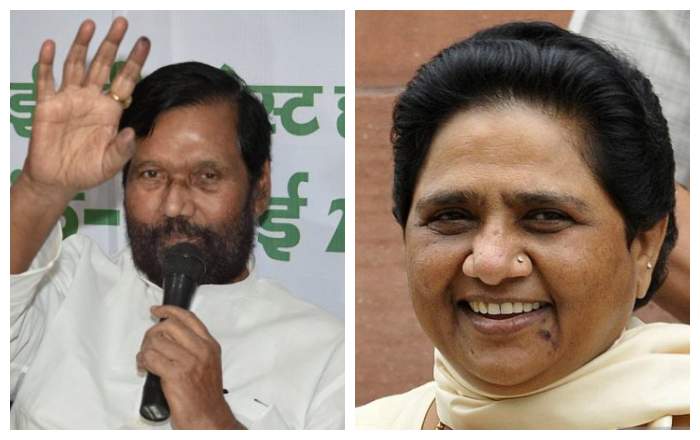Dussadh (Paswan) and Ravidas (Cobbler), the castes to which Ram Vilas Paswan and Mayawati respectively belong are socially, economically and educationally the most empowered Dalit sub-castes of North India. Today they are the ones facing the biggest challenge.
While Dussadhs are more or less confined to Bihar and Jharkhand, Ravidas have a big population in UP, Bihar, Jharkhand, Punjab, Haryana, Gujarat etc. They are addressed by different names in other states, and have almost pan-India presence. But it was in UP and to some extent Punjab, the home state of the Bahujan Samaj Party founder, late Kanshi Ram, that if not all the Dalits, at least a sizeable section of them got a brief opportunity to rise to power.
In Bihar the founder of Lok Janshakti Party, Ram Vilas Paswan, could never become the chief minister but by sheer political maneuvering managed to serve as the Union minister under different regime for 17 years. After his death on October 8 and the complete decimation of his party in the recently concluded Bihar Assembly election it is feared that the most aggressive Dalit sub-caste of Bihar has been cut to size. Now that the BJP has fielded former deputy chief minister Sushil Kumar Modi––and his election is just a formality–for the Rajya Sabha seat vacated following Ram Vilas Paswan’s death it is clear that PM Narendra Modi is in no mood to induct any LJP leader into the cabinet.
BSP’s Marginalisation
The four consecutive routs of the BSP—in the 2012 and 2017 Assembly elections and 2014 and 2019 Lok Sabha polls—have completely marginalized the most vocal section of Dalits–Ravidas, which forms about 14 per cent of UP’s population. In all 21.3 per cent of population in UP are Dalits. Thus, Ravidas form about two-thirds of the Dalit population.
As old habits die hard there are still many social scientists who talk about the empowerment of Dalits when the fact is that in the last few years they have grown further weak. In time to come there appears to be hardly any scope for their revival. However, it is also true that young Dalit leaders like Chandrashekar Azad Ravan of UP and Jignesh Mewani of Gujarat are trying to inject new life in the Dalit movement.
In Maharashtra Prakash Ambedkar and Ramdas Athawale, who is a minister in the Narendra Modi cabinet are on their own not big Dalit forces in their own state—what to speak of nationally.
It may be that both Ram Vilas and Mayawati ignored other Dalit sub-castes when they were at the peak of the popularity the truth is that they at least, may be for their own ulterior political motive, kept the larger issue of SCs alive.
Mainstreaming of Dalits
As a counter-argument one may say that the weakening of the Dalit-specific party amounts to the mainstreaming of the Scheduled Castes. Thus they too are voting for the national parties as they used to for Congress in the early post-independence years and now the BJP.
But as the mainstreaming of Dalits did not bring about any change in their condition. Dalit Panthers, Dalit Sena and Bahujan Samaj Party came up in 1970s and 1980s.
While the influence of Dalit Panthers was confined to Maharashtra, it was Ram Vilas who established Dalit Sena and Kanshi Ram and Mayawati the BSP.
Another Dalit figure Udit Raj emerged. However, he later joined the BJP and got elected its MP in 2014. But he later left the party and has joined the Congress. He is the National Chairman of the All India Confederation of SC/ST Organisations.
Be it Ram Vilas, Mayawati or Prakash Ambedkar they have sought support of other castes and communities to expand the base of their respective parties. The BSP even went to the extent of sharing power with the Brahmins.
Mahadalit Experiment
In Bihar Nitish Kumar, after coming to power in Nov 2005 tried to woo Dalits away from the LJP, RJD and even CPI-ML.
His government floated the idea of Mahadalits and included 18 out of the 22 Scheduled Castes in it. The argument was that the creamy layer of the SCs, that is Dussadh, Ravidas, Pasi (toddy-seller) and Dhobi (washerman) have walked away with all the benefits meant for Dalits. Later under political compulsion, Nitish included three other Dalit sub-castes into Mahadalit category leaving behind just the Dussadh.
Ram Vilas was then in the UPA. The origin of his tussle with Nitish can be traced to that very early years of the latter’s rule in Bihar. This is because LJP is predominantly a Dussadh party.
He joined the NDA in Feb 2014, that is on the eve of Lok Sabha election, when Nitish was the number one rival of the saffron party.
Musahar Factor
With Dussadh and Ravidas getting marginalized in North India, the weakest of Dalit group, the Musahar, or the rat-eaters, have emerged as the strongest votaries of the NDA in the recently held Assembly election in Bihar. The leader of Hindustani Awam Morcha and former CM Jitan Ram Manjhi (himself a Musahar) has four MLAs in the ruling coalition in Bihar.
His son Santosh Manjhi, who actually got elected to the Legislative Council, by the support of the RJD sometimes back, is a minister in the Nitish cabinet. His father was expecting a better reward possibly the Rajya Sabha seat vacated after Ram Vilas Paswan’s death. But it went to Sushil Modi. Yet he has not lost the hope.
(Soroor Ahmed is a senior journalist based in Patna)





